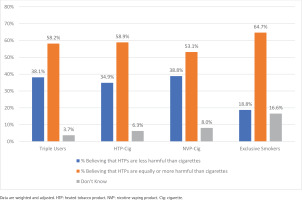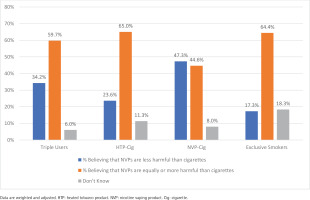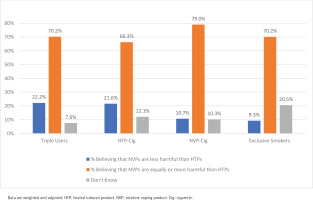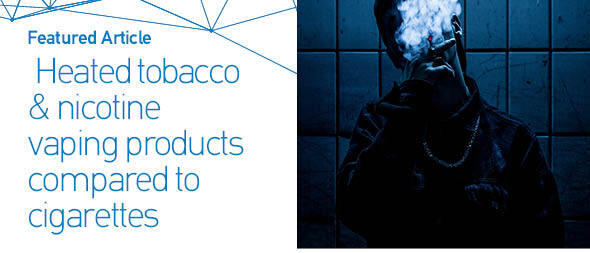INTRODUCTION
A new generation of non-combustible nicotine products has emerged in the last decade, such as nicotine vaping products (NVPs) or e-cigarettes. Scientific reviews have concluded that although NVPs are not harmless1,2, completely switching from cigarettes to NVPs can greatly reduce exposure to several toxicants, including carcinogens3-5. Less is known about the safety profile of the exclusive use of HTPs, but some evidence indicates that they may reduce consumers’ exposure to several chemicals found in cigarettes6.
HTPs and NVPs are legal in the Republic of Korea (hereinafter referred to as ‘South Korea’), and both products are used by a substantial percentage of the population, with greater prevalence among men and those who smoke cigarettes7-10. NVPs were first introduced in South Korea in 2007 and were initially advertised in South Korea as ‘incredible smoking cessation devices’, ‘a less harmful alternative to cigarettes’, and ‘healthy cigarettes’11. However, as marketing regulations became more restrictive12, NVP advertising became more focused on branding, design, and technology, and less focused on product risk13,14. In recent years, the South Korean government has discouraged NVP use15.
Following the successful national launch of IQOS by Philip Morris International (PMI) in Japan in 2016, IQOS was introduced to the South Korean market in May 2017. In 2018, Korea Tobacco & Ginseng Corporation and British American Tobacco introduced their own HTPs – ‘lil’ and ‘glo’, respectively. Similar to the marketing strategies seen in Japan, the tobacco industry marketed HTPs in South Korea as a ‘less harmful’ and as a ‘clean’ alternative to cigarettes. And while PMI and other tobacco companies have made claims that switching completely from cigarettes to a HTP would reduce health risk, the majority of South Korean HTP consumers also smoke cigarettes16.
Tobacco advertising, packaging, and health warnings communicate messages to the public about product characteristics17, in turn shaping consumers’ perceptions about tobacco/nicotine products, including health risks. In South Korea, HTP tobacco refills and NVP e-liquids containing nicotine extracted from tobacco leaves are subject to the same marketing regulations as tobacco cigarettes18,19. Advertisements of both products are allowed in retail stores and media channels, with some exceptions. Pictorial health warnings are also required, covering 50% of the front and back of packaging20. Tobacco packaging cannot include misleading descriptors such as ‘low tar’, ‘light’, or ‘mild’. Supplementary file Table 1 shows tobacco product regulations for tobacco advertising, promotion, and sponsorship (TAPS) and heath warning labels in South Korea.
Studies have shown that among people who smoke cigarettes and perceive NVPs as less harmful than cigarettes are more likely to use them21,22, including for smoking cessation purposes23. In Japan, cigarette smokers who reported having been exposed to marketing of HTPs, were more likely to be using them and perceive HTPs as less harmful24. There is, however, limited research on how adults who smoke in South Korea perceive the relative risks of HTP and NVPs to cigarettes, and whether marketing exposure might be associated with those perceptions. To our knowledge, only one study has examined tobacco users’ relative harm perceptions of HTPs and NVPs compared to cigarettes in South Korea, which found that about a quarter of adult tobacco product users perceived HTPs and NVPs to be less harmful than cigarettes (a majority believe that they are equally or more harmful than cigarettes)25. Thus, our study aimed to compare Korean adult cigarette smokers’ perceptions of relative harmfulness between HTPs, NVPs and cigarettes to the study by Kim et al.26. Additionally, we also examined perceptions of relative harmfulness of NVPs to HTPs, and tested whether exposure to HTP/NVP advertising via various marketing outlets was related to beliefs that they are less harmful than cigarettes compared to those who reported not being exposed to advertisements.
METHODS
Study design, setting, participants
Cross-sectional data for this study were from Wave 1 of the International Tobacco Control Korea (ITC KRA1) Survey (conducted in June 2020), a web-based study of 4794 adults (aged 19 years) recruited from Rakuten Insight’s web panel26. Those who exclusively smoke cigarettes, use HTPs and/or NVPs (at least weekly), former cigarette smokers, and non-nicotine product consumers were invited to participate and completed the online survey. The response rate was 15.2% and the cooperation rate was 97.4%. A detailed description of the sample and methods are reported in the Wave 1 Korea technical report26.
This cross-sectional study included 3713 adults who were smoking cigarettes at least weekly at the time of the survey, of whom 1845 were exclusive smokers, 1130 were dual HTP + cigarette consumers, 224 were dual NVP + cigarette consumers, and 514 were triple consumers (sample selection in Supplementary file Figure 1). The study protocol for involving human data was in accordance with the Declaration of Helsinki.
Measures
All survey content was initially developed in English in collaboration between Korean and Canadian research team members. The final English survey was then translated into Korean by a professional translator at the survey firm (Rakuten Insight). The Korean translation was checked and verified by Korean researchers to meet the standards for the highest possible degree of clarity and accuracy and have the closest equivalence to the English survey content. The full survey can be found at: https://itcproject.org/surveys/republic-korea/kra1-cohort3/ .
Independent variables
All respondents were asked whether they were smoking cigarettes or using an NVP or HTP at the time of the survey. If respondents were smoking cigarettes at least weekly, then they were considered eligible for the study. The sample was divided into four groups based on their self-reported product use at the time of completing the survey:
Exclusive smokers: those who smoke cigarettes at least weekly (e.g. some days of the week or every day) and not using HTPs or NVPs;
Dual HTP + cigarette consumers: those who smoke cigarettes and use HTPs at least weekly (not using NVPs);
Dual NVP + cigarette consumers: those who smoke cigarettes and use NVPs at least weekly (not using HTPs); and
Triple consumers: those who use all three products at least weekly.
Covariates
Sex, age group, annual household income, and education level were used as covariates in this study.
Outcome measures
Supplementary file Table 2 describes the outcome measures with original survey response options. In brief, respondents were asked: 1) ‘Compared to smoking ordinary cigarettes, how harmful do you think it is to use a heated tobacco product?’; 2) ‘Compared to smoking ordinary cigarettes, how harmful do you think it is to use a liquid e-cigarette?’; and 3) ‘Compared to using a liquid e-cigarette, how harmful do you think using a heated tobacco product is?’. For questions 1 and 2, the outcome was dichotomized into: ‘they are less harmful than cigarettes’ versus ‘they are equally or more harmful than cigarettes/don’t know’. For question 3, the outcome was dichotomized into: ‘NVPs are less harmful than HTPs’ versus ‘NVPs are equally or more harmful than HTPs/‘don’t know’.
Respondents were also asked: ‘In the last 6 months have you noticed [heated tobacco products] [liquid e-cigarette products] being advertised in any of the following places?’: TV; radio; newspapers or magazines; posters or billboards; stores where tobacco is sold; stores where HTPs are sold; stores where NVPs are sold; social media; and bars or pubs. Respondents could select all that applied. Responses were dichotomized as: ‘Yes’ (if respondents reported noticing advertising for one or both products for each location) or ‘No’ (if respondents reported ‘no’ or ‘don’t know’ to both questions).
Statistical analysis
Unweighted data were used to describe the study sample, overall, and by user group status. Chi-squared was used to test whether there were differences in sample characteristics between the four user groups. All subsequent analyses were weighted. A raking algorithm was used to calibrate the weights to target marginal joint population distributions of cigarette, HTP, and NVP use, geographical region, and demographic measures. All analyses were conducted using SAS Version 9.4. Statistical significance and confidence intervals were computed at the 95% confidence level, and all tests were two-tailed.
Three multinomial regression models were conducted to compute weighted and adjusted estimates for perceived relative harmfulness for HTPs relative to cigarettes, NVPs relative to cigarettes, and NVPs relative to HTPs. The outcomes included: ‘less harmful’ versus ‘equally/more harmful’ versus ‘don’t know’. The reference group used for this analysis was ‘equally/more harmful’. Each of the models compared the perceptions of harmfulness between the four different user groups and controlled for geographical region, education level, income, age, and sex.
Adjusted logistic regression analyses were conducted to test whether exposure (vs no exposure) to HTP/NVP advertising in each of the 10 locations was associated with perceptions of lower relative harmfulness of HTPs and NVPs compared to cigarettes, adjusting for region, age group, sex, education level, and income.
RESULTS
Table 1 presents the (unweighted) characteristics of the study sample. In brief, the majority of the sample were men (79.8%), daily smokers (87.8%), aged 40–59 years (53.9%), had a higher level of education (80.1%) and a moderate household income (57.5%).
Table 1
Descriptive characteristics of the study sample of adults who smoke cigarettes (at least weekly), Republic of Korea, June 2020 (N=3713)
| Characteristics | Exclusive cigarette smokers (N=1845) % | HTP + cigarette consumers (N=1130) % | NVP + cigarette consumers (N=224) % | Triple consumers* (N=514) % | All respondents (N=3713) % | p |
|---|---|---|---|---|---|---|
| Sex | <0.001 | |||||
| Male | 84.0 | 78.0 | 76.8 | 70.2 | 79.8 | |
| Female | 16.0 | 22.0 | 23.2 | 29.8 | 20.2 | |
| Age (years) | <0.001 | |||||
| 19–29 | 9.7 | 8.9 | 20.1 | 15.2 | 10.8 | |
| 30–39 | 21.3 | 29.1 | 34.4 | 37.4 | 29.7 | |
| 40–59 | 57.6 | 54.7 | 43.8 | 43.0 | 53.9 | |
| ≥60 | 11.5 | 7.4 | 1.8 | 4.5 | 8.7 | |
| Education level | <0.001 | |||||
| Low | 1.0 | 0.4 | 0 | 0.4 | 0.7 | |
| Moderate | 23.6 | 12.2 | 22.8 | 13.8 | 18.7 | |
| High | 75.1 | 86.9 | 76.3 | 85.0 | 80.1 | |
| Not reported | 0.3 | 0.4 | 0.9 | 0.8 | 0.5 | |
| Income | <0.001 | |||||
| Low | 17.6 | 7.8 | 17.4 | 9.5 | 13.5 | |
| Moderate | 58.8 | 57.0 | 57.1 | 54.5 | 57.5 | |
| High | 21.3 | 34.1 | 22.8 | 35.2 | 27.2 | |
| Not reported | 2.4 | 1.2 | 2.7 | 0.8 | 1.8 | |
| Smoking frequency | <0.001 | |||||
| Daily | 90.9 | 87.2 | 81.7 | 80.5 | 87.8 | |
| Weekly | 9.1 | 12.8 | 18.3 | 19.5 | 12.2 | |
| HTP use frequency | <0.001 | |||||
| Daily | 0.0 | 66.1 | 0.0 | 64.2 | 36.2 | |
| Weekly | 0.0 | 33.9 | 0.0 | 35.8 | 31.6 | |
| Not at all | 100 | 0 | 100.0 | 0.0 | 32.2 | |
| NVP use frequency | <0.001 | |||||
| Daily | 0 | 0 | 49.1 | 47.1 | 15.8 | |
| Weekly | 0 | 0 | 50.9 | 52.9 | 30.3 | |
| Not at all | 100 | 100 | 0 | 0 | 54.0 |
* Triple consumers: those reporting using all three products at least weekly. Data are unweighted and unadjusted. Chi-squared tests were utilized to derive p values. Annual household income (Korean Won): low, <10 million (US$7700); moderate, 10–75 million (US$58000); high, ≥75 million; and ‘not reported’. Education: low, <high school; moderate, high school and some college; high, ≥undergraduate degree; and ‘not reported’.
Perceptions of relative harmfulness
Table 2 presents estimates for relative harmfulness perceptions among all respondents. The majority of respondents reported that they perceive HTPs and NVPs as equally as harmful as cigarettes (53.7% and 49.9%, respectively), and NVPs as equally harmful as HTPs (55.4%).
Table 2
Perceived harmfulness of heated tobacco products relative to cigarettes, nicotine vaping products relative to cigarettes, and nicotine vaping products relative to heated tobacco products among adults who smoke cigarettes, Republic of Korea, June 2020 (N=3173)
[i] Multinomial regression models were conducted to compute weighted and adjusted estimates for perceived relative harmfulness for HTPs relative to cigarettes, NVPs relative to cigarettes, and NVPs relative to HTPs. The models adjusted for geographical region, income, education level, age, and sex. HTPs: heated tobacco products. NVPs: nicotine vaping products.
Figure 1 presents the estimates across user groups for perceived harmfulness of HTPs compared to cigarettes. The majority (61.3%) of all respondents perceive HTPs to be equally or more harmful compared to cigarettes. Exclusive smokers were significantly less likely to perceive that HTPs are less harmful than cigarettes (18.9%) compared to dual HTP + cigarette consumers (34.9%, p<0.001), dual NVP + cigarette consumers (38.8%, p<0.001) and triple consumers (38.1%, p<0.001). Perceptions of lower harmfulness did not differ between triple consumers and dual NVP + cigarette consumers (p<0.75).
Figure 1
Perceived harmfulness of HTPs compared to cigarettes among adults who smoke cigarettes, Republic of Korea, June 2020 (N=3137)

Figure 2 presents the estimates across user groups for perceived harmfulness of NVPs compared to cigarettes. The majority of all respondents (62.7%) reported that they perceive NVPs as equally or more harmful compared to cigarettes. Exclusive smokers were less likely to believe that NVPs are less harmful than cigarettes (17.3%) compared to dual NVP + cigarette consumers (47.3%, p<0.001), dual HTP + cigarette consumers (23.6%, p<0.01) and triple consumers (34.2%, p<0.001). Triple consumers were less likely to report that NVPs are less harmful than cigarettes compared to dual NVP + cigarette consumers (p<0.01), but more likely than dual HTP + cigarette consumers (p<0.001).
Figure 2
Perceived harmfulness of NVPs compared to cigarettes among adults who smoke cigarettes, R epublic of Korea, June 2020 (N=3137)

Figure 3 presents the estimates across user groups for perceived harmfulness of NVPs compared to HTPs. Among all respondents, 69.5% perceive that NVPs are equally or more harmful than HTPs. Exclusive smokers were less likely to believe that NVPs are less harmful than HTPs (9.3%) compared to dual HTP + cigarette consumers (21.6%, p<0.001), and triple consumers (22.1%) (all p<0.001), but did not differ from dual NVP + cigarette consumers (10.7%, p=0.16). Triple consumers were more likely to report that NVPs are less harmful than HTPs compared to dual NVP + cigarette consumers (p<0.01), and dual HTP + cigarette consumers (p<0.01).
Figure 3
Perceived harmfulness of NVPs compared to HTPs among adults who smoke cigarettes, Republic of Korea, June 2020 (N=3137)

The associations of different marketing exposures and perceptions of relative harm of HTPs and NVPs compared to cigarettes are presented in Table 3. In summary, exposure (vs no exposure) to marketing across all advertising platforms, with the exception of television, were significantly associated with perceiving HTPs and NVPs as less harmful than cigarettes (all p<0.001). The three locations of exposure that were associated with the highest odds of perceiving that HTPs/NVPs are less harmful than cigarettes were: transportation adds (unexposed: 26.0% vs exposed: 46.1%; AOR=2.44; 95% CI: 1.71–3.48), newspapers/magazines (unexposed: 25.0% vs exposed: 40.2%; AOR=2.01; 95% CI: 1.50–2.69) and stores where tobacco is sold (unexposed: 13.1% vs exposed: 35.2%; AOR=1.90; 95% CI: 1.46–2.45).
Table 3
Associations between exposure to heated tobacco/nicotine vaping product advertising locations in the past 6 months and the perception that heated tobacco and nicotine vaping products are less harmful than cigarettes among adults who smoke, Republic of Korea, June 2020 (N=3713)
[i] AOR: adjusted odds ratio. Adjusted logistic regression analyses were used to test whether exposure (vs no exposure) to heated tobacco product/nicotine vaping product advertising in each of the 10 locations was associated with perceptions of lower relative harmfulness of heated tobacco and nicotine vaping products compared to cigarettes. Data are weighted and adjusted for geographical region, education level, user group, age, and sex. HTPs: heated tobacco products. NVPs: nicotine vaping products. The p-values were derived from multivariable logistic regression models.
DISCUSSION
This study examined South Korean adult smokers’ perceptions of the harmfulness of HTPs and NVPs compared to cigarettes, and to each other, and tested whether exposure to various advertising mediums was associated with believing that HTPs/NVPs are less harmful than cigarettes. We found that about a quarter of smokers perceived HTPs and NVPs to be less harmful than cigarettes, which is consistent with the study by Kim et al.25 who found in 2019 that 26% of adult tobacco users believed that HTPs and NVPs were less harmful than cigarettes. Also consistent with Kim et al.25 and smokers in Japan24, we found that exclusive smokers (non-HTP and non-NVP consumers) were less likely to hold this believe compared to those who use the products. However, in contrast to our findings, Kim et al.24 found a much higher proportion of tobacco users who believe that HTPs (38%) and NVPs (41%) are more harmful than cigarettes, whereas we found that the majority (55%) believed that HTPs and NVPs are equally as harmful (fewer than 10% believed that HTPs were more harmful than cigarettes and 13% believed NVPs were more harmful than cigarettes in our study). A similar proportion of respondents in each of the studies reported they did not know. Thus, although there is evidence that completely switching from cigarettes to HTPs or NVPs likely reduces exposure to several cigarette-related toxicants, the majority of Korean smokers in both our study and in Kim et al.25 believe that HTPs/NVPs are not less harmful than cigarettes, regardless of whether they use them or not. As it has been shown that smokers’ perceptions of the harmfulness of NVPs relative to cigarettes predicted the respective product use when trying to quit cigarette smoking23, many Korean smokers may be reluctant to use HTPs or NVP to quit smoking, or as a complete substitute for cigarettes, although this has not yet been tested in South Korea.
Cytotoxicity studies have found that harmful chemicals are lower in HTPs than cigarettes, but higher in HTPs relative to NVPs4,27. Thus, in addition to examining relative risk perceptions between cigarettes and HTPs/NVPs, we also examined whether smokers perceive that HTPs and NVPs differ in harmfulness, which was not addressed in the Kim et al.25 study. We found that about half (55%) of Korean smokers perceive HTPs and NVPs as being equally harmful (70% reported believing that NVPs are equally/more harmful than HTPs), with only 14% of all respondents correctly perceiving that HTPs are more harmful than NVPs. Another ITC study that assessed relative risk between HTPs and NVPs among Canadian nicotine users found that a similar proportion of respondents reported believing that HTPs are more harmful than NVPs (17%)28. However, a higher proportion of Canadian respondents reported that HTPs are less harmful than NVPs (23%) in the Canada study compared to Korean respondents (15%). The results from these two studies appear to show perceptions of harmfulness are not consistent with the current evidence that NVPs expose consumers to lower levels of toxicants than HTPs.
HTPs have been launched and marketed in several countries; however, HTP market growth has generally been slow in most countries, with the exception of Japan and Korea29. Comparing perceptions of relative risk between HTPs, NVPs, and cigarettes across studies with similar study measures and sampling frames in countries with similar or differing levels of success and policy regulations, including and marketing restrictions is warranted. For example, analyses of our ITC Japan Survey found that in 2018, 48% of smokers perceived HTPs to be less harmful than cigarettes24; however, this declined over time to 28.3% in 202030. We have speculated that this large reduction in perceptions of relative harmfulness among Japanese smokers may have been due to changes in Japan’s HTP policies: in 2018, there were no restrictions on use or marketing of HTPs31, but by 2020, HTPs were banned in key public places and text health warnings were mandated on 1 April 2020 on HTP tobacco heat stick packaging32. Thus, after Japan introduced stricter regulations, perceptions were similar between Japan and South Korea in 2020.
When we compared our estimates to other ITC countries, we found stark differences between this study and the Santos et al.28 study in Canada (which regulates HTPs and NVPs under the Tobacco and Vaping Products Act33). We found that a much greater percentage of Canadian respondents reported believing that HTPs (48%) and NVPs (66%) are less harmful than cigarettes. Gravely et al.22 assessed relative risk perceptions among smokers from six European countries (where NVPs are regulated under the EU Tobacco Products Directive34) and found that a quarter of smokers perceived NVPs as less harmful than cigarettes, with some variations across the countries (ranging from 22% in Spain to 34% in Hungary). The differences between Canada and South Korea may be that the Canadian government appears to have taken a different approach to NVPs, in that Health Canada’s Tobacco Strategy stated that NVPs could be helpful for smokers attempting to quit, particularly if they were unsuccessful with other medically approved cessation aids35, but that youth and never smokers should not use them, whereas the EU has taken a less supportive stance36, which is more aligned with the position of the South Korean government.
Finally, the results from our study demonstrate that smokers who were exposed to HTP/NVP advertising were more likely to hold the belief that these products are less harmful than cigarettes. We also found this in the ITC Japan Survey24. However, both of these studies were cross-sectional so we cannot determine if risk perceptions preceded or followed exposure. We also found in the Japan study that HTP consumers were more likely to be exposed to advertising than non-HTP consumers, likely because they visit locations where HTPs are sold, and/or they are more aware of the product. However, it is notable that even after exposure to advertising in South Korea, the minority of respondents perceived HTP/NVPs as less harmful than cigarettes, which may be due to the industry’s shift in focus from product risk to marketing product branding, design, and technology. As to whether marketing strategies change beliefs about the relative risk of HTPs and NVPs requires further study using longitudinal cohort designs.
Limitations
While this study has many strengths, including the large sample size of representative cigarette smokers and HTP and NVP consumers in South Korea, there are limitations to consider. First, this study is cross-sectional; thus, we do not attempt to imply causality. Second, the assessment of exposure to advertising outlets could be subject to recall bias. Lastly, the generalizability of findings is limited to only those who use HTPs and/or frequently (at least weekly) and/or who smoke cigarettes, and are not representative of the general South Korean population or those who may have experimented with HTPs and/or NVPs.
CONCLUSIONS
Even though current existing scientific data show lower exposure to toxic substances from HTPs and NVPs than from cigarettes, only a quarter of South Korean smokers believe that HTPs and NVPs are less harmful than cigarettes. Those who used HTPs and/or NVPs were more likely than non-consumers to hold the belief that they are less harmful. Most respondents perceive that HTPs and NVPs have a similar risk profile when compared to each other, with few believing that NVPs are less harmful than HTPs. Future research should identify both the absolute and relative exposure to toxins and health risks from cigarettes, HTPs, and NVPs. Risk communication about HTPs and NVPs should align with the best-available scientific evidence.


